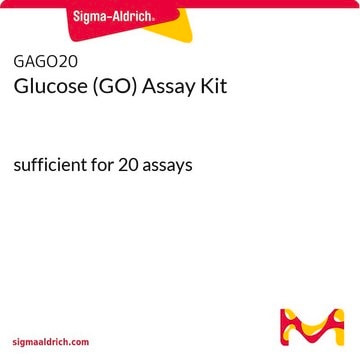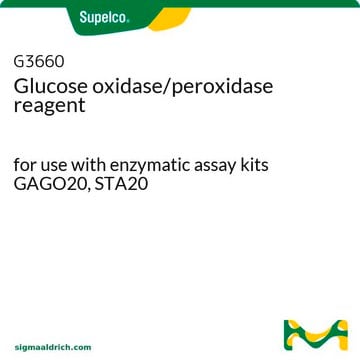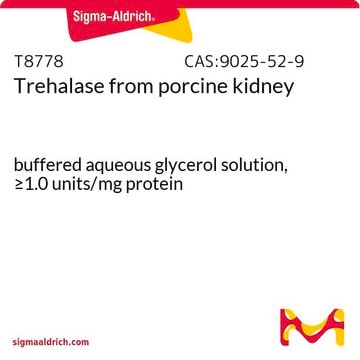If this product has an expiration or retest date, it will be shown on the Certificate of Analysis (COA, CofA). If there is no retest or expiration date listed on the product's COA, we do not have suitable stability data to determine a shelf life. For these products, the only date on the COA will be the release date; a retest, expiration, or use-by-date will not be displayed.
For all products, we recommend handling per defined conditions as printed in our product literature and website product descriptions. We recommend that products should be routinely inspected by customers to ensure they perform as expected.
For products without retest or expiration dates, our standard warranty of 1 year from the date of shipment is applicable.
For more information, please refer to the Product Dating Information document: https://www.sigmaaldrich.com/deepweb/assets/sigmaaldrich/marketing/global/documents/449/386/product-dating-information-mk.pdf
Wichtige Dokumente
G3293
Glucose-Assay-Reagenz
for use with enzymatic assay kits GAHK20, SCA20, FA20, SA20
Größe auswählen
Größe auswählen
About This Item
Empfohlene Produkte
chemische Klasse(n) des Analyten
sugars (glucose)
Methode(n)
photometry: suitable
Verunreinigungen
≤0.005% Creatine phosphokinase, glutathione reductase, myokinase, NADH-oxidase,NADPH oxidase, phosphogluconic dehydrogenase, phosphoglucose isomerase, lactic dehydrogenase
<0.01% ATP-ase, myokinase
Anwendung(en)
food and beverages
general analytical
Lagertemp.
2-8°C
Spezifität
Anwendung
Ähnliches Produkt
Lagerklassenschlüssel
11 - Combustible Solids
WGK
WGK 3
Flammpunkt (°F)
Not applicable
Flammpunkt (°C)
Not applicable
Persönliche Schutzausrüstung
Eyeshields, Gloves, multi-purpose combination respirator cartridge (US)
Hier finden Sie alle aktuellen Versionen:
Analysenzertifikate (COA)
Die passende Version wird nicht angezeigt?
Wenn Sie eine bestimmte Version benötigen, können Sie anhand der Lot- oder Chargennummer nach einem spezifischen Zertifikat suchen.
Besitzen Sie dieses Produkt bereits?
In der Dokumentenbibliothek finden Sie die Dokumentation zu den Produkten, die Sie kürzlich erworben haben.
Protokolle
Enzymatic Assay of α-Glucosidase by the Modified Boehenger Procedure (EC 3.2.1.20)
To standardize an enzymatic assay procedure of cellulase.
This procedure may be used for the determination of Amyloglucosidase activity using starch as the substrate.
-
How can I determine the shelf life / expiration / retest date of this product?
1 Antwort-
Hilfreich?
-
-
How is shipping temperature determined? And how is it related to the product storage temperature?
1 Antwort-
Products may be shipped at a different temperature than the recommended long-term storage temperature. If the product quality is sensitive to short-term exposure to conditions other than the recommended long-term storage, it will be shipped on wet or dry-ice. If the product quality is NOT affected by short-term exposure to conditions other than the recommended long-term storage, it will be shipped at ambient temperature. As shipping routes are configured for minimum transit times, shipping at ambient temperature helps control shipping costs for our customers. For more information, please refer to the Storage and Transport Conditions document: https://www.sigmaaldrich.com/deepweb/assets/sigmaaldrich/marketing/global/documents/316/622/storage-transport-conditions-mk.pdf
Hilfreich?
-
-
For how many tests this reagent will be sufficient?
1 Antwort-
This product is available in a 20 mL or 50 mL package size. The entire vial should be reconstituted in DI water as indicated by the package size. Each test requires 1 mL of this reagent. The 20 mL package size is sufficient to perform 20 test and the 50 mL pack size is sufficient to perform 50 tests.
Hilfreich?
-
-
How much of the initial must be reconstituted in 20 ml of DI water?
1 Antwort-
The entire vial should be reconstituted to the volume of the package size. The G3293-20 mL with 20 mL of DI water and the G3293-50 mL with 50 mL of DI water.
Hilfreich?
-
-
Is magnesium required for Product G3293, Glucose Assay Reagent?
1 Antwort-
Magnesium, an activator of hexokinase, is included in the assay reagent. There is no need to add a magnesium salt to the reagent before use.
Hilfreich?
-
-
What is the Department of Transportation shipping information for this product?
1 Antwort-
Transportation information can be found in Section 14 of the product's (M)SDS.To access the shipping information for this material, use the link on the product detail page for the product.
Hilfreich?
-
-
Is it possible to adapt Product G3293, Glucose Assay Reagent, for use with a 96 well plate reader?
1 Antwort-
In principle, it should be possible to adapt assay procedures using this reagent to 96-well plate readers. Volumes of reagent, water, standard, and unknown should be reduced to fit the capacity of the test wells, and kept in the same proportions as those used with a spectrophotometer. The volume reduction will likely be 1:4 or 1:5. With the shorter "pathlength" of a multiwell plate, the sensitivity of the assay would likely decrease.
Hilfreich?
-
-
What is the detection limit of Product G3293, Glucose Assay Reagent?
1 Antwort-
This reagent should be able to detect glucose down to approximately 0.01 mg/mL using a spectrophotometer with a 1 cm path length.
Hilfreich?
-
Aktive Filter
Unser Team von Wissenschaftlern verfügt über Erfahrung in allen Forschungsbereichen einschließlich Life Science, Materialwissenschaften, chemischer Synthese, Chromatographie, Analytik und vielen mehr..
Setzen Sie sich mit dem technischen Dienst in Verbindung.







